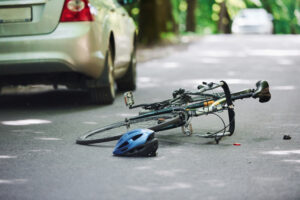Bicycling offers an eco-friendly and healthy mode of transportation, but poorly maintained roads have reportedly transformed pleasant rides into dangerous ordeals.
Road hazards have been associated with destabilizing cyclists and causing deadly bike accidents. Victims of such incidents may face significant injuries and financial losses. When this occurs, consult a bike accident lawyer, who can provide a path to securing deserved compensation.
A legal professional understands the legal framework and can protect your interests. But since governmental negligence can result in many road hazards, you may face severe, short notice of claim and statute of limitations deadlines in your case, so don’t hesitate to call a bicycle accident lawyer today.
Meanwhile, read on to discover how road hazards cause bike accidents and learn how to pursue justice and recovery confidently.
Road Conditions That Cause Bike Accidents
 Not all bicycle accidents are caused by driver negligence or rider error. Certain road conditions pose significant risks to cyclists, leading to accidents with severe consequences.
Not all bicycle accidents are caused by driver negligence or rider error. Certain road conditions pose significant risks to cyclists, leading to accidents with severe consequences.
The following are common hazards that cyclists encounter:
- Potholes: These surface depressions can form from weather damage or poor maintenance. When a bicycle wheel strikes a deep pothole, it can instantly throw the rider off balance or cause a dangerous flip.
- Loose Gravel: Gravel or sand on paved surfaces, especially at curves or intersections, can reduce traction and cause wheels to slide out from under the rider.
- Debris: Objects like fallen branches, vehicle parts left on the roadway, glass, or litter can puncture tires or force cyclists into unsafe maneuvers or traffic lanes.
- Sewer Grates: Improperly placed or designed grates can trap bike wheels, abruptly halting the bicycle and ejecting the rider.
- Inadequate Signage: Missing or unclear signs fail to warn cyclists of hazards like sharp turns or construction zones and prevent them from taking necessary precautions in time.
- Road Construction: Work zones often feature irregular surfaces, unexpected barriers, or unclear detours. Without adequate markings or safe pathways, these areas become high-risk for bicyclists.
These conditions are primarily the result of poor maintenance or oversight and create unpredictable challenges for cyclists. Your bicycle accident lawyer will seek to understand the specific type of road hazard involved to help determine liability and build a strong legal case.
How Road Hazards Lead to Bicycle Accidents
Different road hazards have the capacity to cause bicycle accidents, mainly by disrupting the fundamental elements of safe cycling.
When a road defect causes a bike crash, the physical mechanics of the accident often point directly to the source of the danger. Unlike motorists, cyclists have minimal protection and rely entirely on the stability of the road beneath them.
Here are the primary ways road hazards lead to bicycle accidents:
Loss of Traction
Loose gravel, sand, wet leaves, or oil on the road surface can drastically reduce a bicycle’s ability to grip the pavement. When a tire loses traction, especially during braking or while navigating curves, the rider can easily lose control and skid sideways.
In many cases, this type of hazard is foreseeable and preventable through proper road maintenance or timely cleanup, which may establish negligence on the part of the responsible entity.
Balance Disruption
Potholes, debris, and uneven surfaces can suddenly disrupt a rider’s balance, even at moderate speeds. A jolt from a poorly patched section of pavement or a hidden obstacle can throw the rider off course, leading to falls or collisions with nearby traffic. Because bicycles are lightweight and lack shock absorption, riders are especially vulnerable to slight irregularities in the road that a vehicle can simply absorb or ignore.
Sudden Stopping
Some hazards, such as an uncovered utility hole, a large pothole, or an improperly designed sewer grate, can cause a bike’s front wheel to jam or stop abruptly.
This often results in the cyclist being thrown forward over the handlebars, which can cause head trauma, facial injuries, or broken limbs. These incidents may be tied to negligent roadway design or lack of routine inspections, particularly in areas heavily used by cyclists.
Forced Evasive Maneuvers
When cyclists suddenly encounter an obstacle, they usually must swerve to avoid it. These quick reactions can force the rider into oncoming traffic, parked vehicles, or nearby structures like guardrails or curbs. Even if no direct contact with the hazard occurs, the need for evasive action triggered by a roadway defect can still serve as the basis for a valid legal claim.
Visual Obstructions
Construction signage, overgrown vegetation, or poorly placed barriers can obstruct a cyclist’s line of sight. Without clear visibility of the road ahead, riders may not have enough time to adjust to surface changes, turns, or oncoming dangers. Inadequate maintenance or negligent placement of signs and barriers may place liability on municipal agencies or contractors.
Inadequate Lighting or Reflective Markings
Cyclists riding at dawn, dusk, or night are particularly vulnerable to road hazards that aren’t properly marked or illuminated. Faded lane lines, missing reflectors, or unlit construction zones can conceal hazards until it’s too late to react safely.
When municipalities or contractors fail to maintain proper nighttime visibility, they may be liable for resulting accidents under theories of negligent maintenance or failure to warn.
Slips and Falls
When wet paint, algae, oil, or even construction runoff makes the road surface slick, it can turn a safe path into a hazard. These conditions often lead to uncontrolled slips and fall accidents, causing fractures, concussions, or ligament injuries. Failure to properly treat or warn about a slick surface may expose the responsible party to liability.
Obstructions and Collisions
Fixed objects in the bike lane, like improperly placed cones, parked vehicles, trash bins, or construction materials, often force cyclists into traffic or into the object itself.
Sudden impact with a solid obstruction can result in severe trauma, especially to the head and upper body. If the obstruction was improperly placed or left in violation of safety standards, liability may be clear.
Injuries in Bike Accidents Caused by Road Hazards
 Bicyclists are extremely vulnerable when road conditions fail to meet safety standards. Without the protection of a vehicle frame, even a low-speed crash can result in significant physical trauma.
Bicyclists are extremely vulnerable when road conditions fail to meet safety standards. Without the protection of a vehicle frame, even a low-speed crash can result in significant physical trauma.
Sometimes, the resulting injuries may have such severe consequences that the victims have to deal with mounting medical costs and lost income. This makes it imperative to pursue compensation through legal channels to address these burdens and hold responsible parties accountable.
The following are some of the most common injuries sustained in road hazard-related bicycle accidents:
Head and Brain Injuries
Even with a helmet, cyclists are at high risk of concussions, skull fractures, or traumatic brain injuries (TBIs) when thrown from a bike. These injuries often occur when the rider is propelled over the handlebars or strikes a hard surface after losing balance.
TBIs can cause chronic pain and long-term cognitive, emotional, and functional impairments. This makes them one of the most serious categories of injury in these cases.
Spinal Cord and Back Injuries
Falls caused by potholes, grates, or abrupt stops can lead to spinal trauma, including herniated discs, vertebral fractures, or, in severe cases, paralysis.
Spinal injuries may not present immediately and can worsen over time without proper medical care. These injuries often result in lasting pain, limited mobility, and significant medical expenses, all of which may be recoverable through a legal claim.
Broken Bones and Fractures
Wrist, arm, shoulder, and collarbone fractures are common when a cyclist instinctively tries to break their fall.
Leg and hip fractures may also occur during high-impact crashes, especially when the rider collides with a curb, pole, or vehicle. These injuries frequently require surgery and lengthy rehabilitation, resulting in missed work and substantial financial burdens.
Facial and Dental Trauma
When a rider lands face-first after being thrown off the bike, they may suffer lacerations, dental injuries, broken jaws, or eye trauma. These injuries can be disfiguring and often require reconstructive surgery.
Pain and psychological effects, such as anxiety or self-consciousness, are also compensable under many personal injury claims.
Road Rash and Soft Tissue Injuries
Sliding across pavement can result in deep abrasions, or road rash, that may become infected or cause permanent scarring. Torn ligaments, bruising, and soft tissue trauma are also common, particularly in the shoulders, knees, and ankles. While these injuries may seem less severe, they can cause persistent pain and functional limitations.
After a Bike Accident, What Next?
Following a bike accident caused by road hazards, victims need to take steps to address their injuries and pursue justice. These steps empower you to address a bike accident’s physical and financial toll while holding negligent parties accountable for hazardous road conditions. Also, taking these steps will preserve important evidence for future legal claims.
Here is what to do after a bike crash caused by road hazards:
Prioritize Medical Evaluation and Follow-Up
If you haven’t already done so, seek a full medical evaluation as soon as possible. Delayed treatment of concussions, spinal strain, or internal trauma may complicate recovery.
Follow all the stipulated care plans, attend follow-up appointments, and document your symptoms consistently. This medical record can later serve as reliable evidence of the severity and progression of your injuries.
Preserve Evidence from the Accident
Keep any physical evidence related to the accident, including your damaged bicycle, clothing, bicycle helmet, and other gear. These items may help demonstrate the force of impact or the conditions that caused the crash. Take photographs of your injuries during the healing process and maintain a written account of how the accident has affected your daily life, work, and mobility.
Request Official Reports or Maintenance Records
If a hazardous road condition contributed to your crash, it may be helpful to obtain any relevant maintenance records or incident reports. For example, a prior complaint about the same road defect or a lack of documented repairs may support a negligence claim. A bike accident lawyer can assist in requesting and analyzing these records on your behalf.
Keep a Personal Recovery Journal
Documenting your recovery can be valuable, not just for medical purposes but also for establishing the personal toll the accident has taken. Record your pain levels, mobility restrictions, emotional struggles, and any disruptions to your routines or employment. These personal insights can help communicate the full scope of your damages if you pursue legal action later.
How a Personal Injury Lawyer Can Help After a Road Hazard Bike Accident
 If you suffered an injury in a bike crash caused by unsafe road conditions, a personal injury lawyer can help in standing up for your rights and guiding your recovery. These cases often involve complex questions of public liability, government notice requirements, and detailed investigations into the roadway’s condition. An attorney understands how to approach these challenges and build a winning claim on your behalf.
If you suffered an injury in a bike crash caused by unsafe road conditions, a personal injury lawyer can help in standing up for your rights and guiding your recovery. These cases often involve complex questions of public liability, government notice requirements, and detailed investigations into the roadway’s condition. An attorney understands how to approach these challenges and build a winning claim on your behalf.
From the beginning, your bike accident lawyer can take over the recovery process so you can concentrate on healing. This includes identifying the responsible parties and gathering the evidence needed to prove negligence. They can collect and compile evidence such as:
- Photos of the accident scene and the road hazard
- Damaged bicycle and gear
- Medical records and treatment reports
- Witness statements
- Surveillance or traffic camera footage
- Maintenance logs or repair records for the roadway
- Prior complaints or incident reports about the hazard
- Police or incident reports
- Expert evaluations of the road condition
- Personal injury journal or symptom diary
- GPS or fitness tracker data showing the ride path
- Weather reports at the time of the accident
Your bicycle accident attorney will also document the scope of your injuries, coordinating with medical professionals so as to pursue fair compensation for the personal toll the accident has taken on your life.
They will ensure that available compensation addresses the following:
- Current and future medical care/rehabilitation costs
- Lost income
- Loss of earning capacity
- Pain and suffering
- Emotional distress
- Loss of enjoyment of life
- Permanent disability or impairment
- Scarring or disfigurement
- Cost of bicycle repair or replacement
Should your case involve government entities or require litigation, your bike accident attorney will be prepared to advocate for you at every stage. Their goal is to ensure you are not left bearing the consequences of a hazardous roadway that should have been made safe.
Consult Your Bike Accident Lawyer For Legal Support
Engaging a lawyer with knowledge of bike accident cases is an important step in pursuing compensation. A legal advocate will assess the circumstances of the crash, identify liable parties, and advocate for the victim’s rights to recover damages for medical expenses, lost income, and pain and suffering. Their understanding of legal frameworks ensures your interests are protected throughout the process.
Contact a Redding personal injury attorney near you as soon as possible after the crash to understand your options for seeking recovery.
